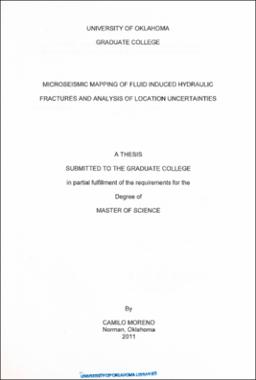| dc.contributor.author | Moreno, Camilo | |
| dc.date.accessioned | 2021-08-26T17:00:12Z | |
| dc.date.available | 2021-08-26T17:00:12Z | |
| dc.date.created | 2011 | |
| dc.date.issued | 2011 | |
| dc.identifier.uri | https://hdl.handle.net/11244/330734 | |
| dc.description | Thesis (M.S.)--University of Oklahoma, 2011. | |
| dc.description | Includes bibliographical references (leaves 195-209). | |
| dc.description.abstract | Microseismic monitoring of hydraulic fractures is done to yield spatial and temporal plots of hypocenters. There are rendered without any estimates of uncertainty leading the engineer to believe the hypocenter locations are absolute. The hypocenter location problem becomes more complex in anisotropic shale reservoirs. Hypocenter locations are determined from the arrival times of P-wave and/ S-waves and a known velocity model. The difference in the velocity structure and complex fracture networks make accurate fracture mapping difficult. I report on a series of laboratory microseismic studies during controlled hydraulic fracturing of limestone, sandstone and a strongly foliated metamorphic rock, pyrophyllite. Uncertainties in each spatial coordinate and rms error for each sample are presented. The importance of surface sensors in reducing the uncertainty of the microseismic event locations is demonstrated however, reduced uncertainty does not show any considerable effect on the interpreted stimulated reservoir volumes. Fracture alignment is controlled as predicted by applied stresses in isotropic materials. However, when applied horizontal stress is low there is little to no control on the fracture orientation. The stimulated reservoir volume (SRV) appears to decrease with high applied horizontal stress. Hydraulic fracture propagation in anisotropic materials is altered by the magnitude of anisotropy but is predictable when the anisotropic elastic constants are included in calculations. Microscopic observations show that fractures are not planar features as assumed by most models, instead they deviate, are discontinuous and bifurcate. These observations also show the existence of both shear and tensile failure. Permeability can be predicted from the distribution of microseismic events. Reasonable values are determined for low permeability rocks. | |
| dc.format.extent | xlii, 213 leaves | |
| dc.format.medium | xlii, 213 leaves : ill. (chiefly col.), col. map ; 29 cm. | |
| dc.language.iso | eng | |
| dc.subject.lcsh | Hydraulic fracturing | |
| dc.subject.lcsh | Microseisms | |
| dc.subject.lcsh | Seismic prospecting | |
| dc.title | Microseismic mapping of fluid induced hydraulic fractures and analysis of location uncertainties | |
| dc.type | Text | |
| dc.contributor.committeeMember | Keller, G. Randy | |
| dc.contributor.committeeMember | Rai, Chandra S. | |
| dc.contributor.committeeMember | Sondergeld, Carl H. | |
| ou.group | Mewbourne School of Petroleum and Geological Engineering | |
